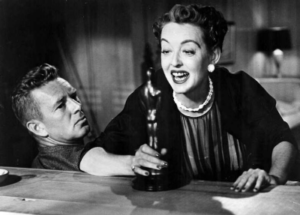Bette Davis and Sterling Hayden in “The Star” (Courtesy of 20th Century Fox)
The story of “The Star” is deceptively simple. Margaret Elliott is an aging, broke, washed-up actress. After an alcoholic binge, Elliott finds herself in jail. Jim, a rugged boat builder played by Sterling Hayden, pays her bail and takes her to recuperate by the seaside. He reveals that he once had aspirations to be in the movies. When his career floundered, however, he decided to go into a different line of work. He encourages Elliott to do the same. Ultimately, Elliott realizes the sagacity of his advice. The final shot of the film shows Elliott coming into Jim’s boathouse, running away from her movie career and towards a more tranquil existence as his wife.
This summary makes “The Star” sound like a lifeless drama, replete with cheap romance and a problematic commentary on a woman’s role in society. Yet, the role of Margaret Elliott is played by Bette Davis, a brilliant actress. With some assistance from screenwriters Dale Eunson and Katherine Albert and director Stuart Heisler, Davis transforms “The Star” into a meditation on the costs of creating cinema.
In later interviews about the film, Davis would try to deemphasize the parallels between her life and her character’s, insisting that the inspiration for Margaret Elliott was her arch-rival Joan Crawford. The similarities between Davis and Elliott, however, are too numerous to ignore. When she made “The Star,” Davis was a middle-aged actress who had been in the movies for 20 years. She was an Oscar-winner, just like Elliott in the film. While she had appeared in successful films such as “Dark Victory,” “Now, Voyager” and “All About Eve,” like Elliott, she was now having difficulty getting roles. Davis not only resembled Elliott in her career, but also in her personal behavior. Like Elliott, Davis smoke and drank and was short-tempered. Davis supported her sister and her mother financially, and in the film, Elliott takes care of her sister’s expenses. Davis was midway through her fourth marriage when she made the film, and Elliott is divorced.
Davis once remarked that she disliked playing heroines because “there’s nothing to hide behind.” She hypothesized that actors fundamentally dislike themselves, so they yearn to play somebody else. Although Elliott resembles Davis, ingeniously, Davis is able to hide behind her. She never shows Margaret Elliott being herself. Instead, she demonstrates that Elliott is constantly acting. Early in the film, Elliott sees her daughter from her failed marriage. Gretchen asks her mother why she hasn’t taken custody of her. Elliott pauses for a moment and her eyes dart back and forth. Very calmly and confidently, she lies, “That’s it, mother has a tiny apartment.” When Gretchen asks her where she is living, she pauses again. In each of these pauses, Elliott seems to be on the verge of telling her daughter the truth. She hasn’t taken custody of her because she cares more about her career than her child. Yet, when she looks back to Gretchen, she decides to carry on the performance.
Elliott is performing in her scenes with Jim too. When she runs into his arms at the end of film, her actions are rehearsed. She stands in the doorway for a few seconds, closes the door, pauses again, smiles a little, then runs toward him. “The Star” is ostensibly a realistic drama, but Davis plays this scene as if it is an ostentatious romance. Therefore, she undercuts the happy ending. Elliott can play the role of the happy wife, but she can never truly be one. In fact, Davis makes the film into a tragedy. Elliott has been acting for so long that she has lost sight of anything genuine.
In some ways, however, Elliott is forced to act. Her previous appearances on the silver screen haunt her. Jim convinces her to get a job in a department store, but she loses her job when two customers find out that she is really a star. Directors refuse to cast her in their films because they know audiences will see her as the leading lady, not as a character actress. When Elliott does land a small part in a film, she insists on looking glamorous and acting regal, even though she is nothing more than a background player. She is trying to give her audience what they expect from her. At one point in the film, Elliott clutches the Oscar she won years ago and drunkenly reflects that she is “going… going… gone,” but she has been in the movies for so long that she can never really be “gone.” People will still watch the films she made at the height of her career, so she is powerless to change her image. The only open option is to continue playing the role of Margaret Elliott.
Even though they have much in common, this is the crucial difference between Davis and Elliott. Elliott is trapped in her own persona, but Davis could always reinvent herself. In “The Star,” she plays a vulnerable actress, but 10 years later, in “Whatever Happened to Baby Jane,” she would portray a vile one. She could be a loyal wife, a cunning schemer or a tragic heroine and bring out the humanity in each character. Unlike Margaret Elliott, Davis was not just a star with shtick. She was an artist with skill.
Contact Amir Abou-Jaoude at amir2 ‘at’ stanford.edu.
